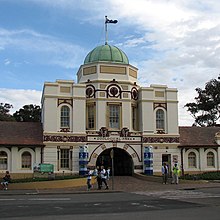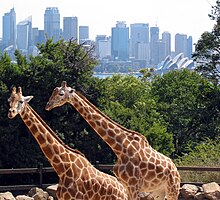| Revision as of 07:46, 20 September 2009 editJaferat (talk | contribs)13 edits →History← Previous edit | Revision as of 07:55, 20 September 2009 edit undoJeff G. (talk | contribs)Autopatrolled, Extended confirmed users, File movers, IP block exemptions, New page reviewers, Pending changes reviewers, Rollbackers116,583 edits Reverted 4 edits by Jaferat to last revision by 98.248.33.198 (HG)Next edit → | ||
| Line 27: | Line 27: | ||
| ]s in front of Sydney's skyline.]] | ]s in front of Sydney's skyline.]] | ||
| ] | ] | ||
| The first public zoo in ] opened in 1884 at Billy Goat Swamp in ], on a site now occupied by ] and ]. Inspired by a 1908 visit to the Hamburg Zoo,<ref></ref> the secretary of the zoo, ], envisioned a new zoo based on the bar-less concept. After realising that the Moore Park site was too small, the NSW Government granted {{convert|43|acre}} of land north of ]. A further {{convert|9|acre}} were later granted in 1916. |
The first public zoo in ] opened in 1884 at Billy Goat Swamp in ], on a site now occupied by ] and ]. Inspired by a 1908 visit to the Hamburg Zoo,<ref></ref> the secretary of the zoo, ], envisioned a new zoo based on the bar-less concept. After realising that the Moore Park site was too small, the NSW Government granted {{convert|43|acre}} of land north of ]. A further {{convert|9|acre}} were later granted in 1916. | ||
| Taronga is an ] word meaning ''beautiful view''. <ref>''The Book of Sydney Suburbs'', Compiled by Frances Pollen, Angus & Robertson Publishers, 1990, Published in Australia ISBN 0-207-14495-8, page 181 </ref> | Taronga is an ] word meaning ''beautiful view''. <ref>''The Book of Sydney Suburbs'', Compiled by Frances Pollen, Angus & Robertson Publishers, 1990, Published in Australia ISBN 0-207-14495-8, page 181 </ref> | ||
| Line 33: | Line 33: | ||
| === Rustic Bridge === | === Rustic Bridge === | ||
| The "Rustic Bridge" was opened in 1915 and was one of Taronga Zoo's earliest landscape features. It was the main way in which visitors could cross the natural ] that it spans. Early photographs show it as a romantic pathway secluded by plantings. The ] was created by embedding stones in the wall and like the Aquarium, its design was reminiscent of Italian ]. A tunnel under the bridge that originally connected the Upper and Lower Aquariums has long been blocked at both ends and is also popular. | The "Rustic Bridge" was opened in 1915 and was one of Taronga Zoo's earliest landscape features. It was the main way in which visitors could cross the natural ] that it spans. Early photographs show it as a romantic pathway secluded by plantings. The ] was created by embedding stones in the wall and like the Aquarium, its design was reminiscent of Italian ]. A tunnel under the bridge that originally connected the Upper and Lower Aquariums has long been blocked at both ends and is also very popular. | ||
| === Later additions and changes === | === Later additions and changes === | ||
Revision as of 07:55, 20 September 2009
Zoo in New South Wales, AUS| Taronga Zoo | |
|---|---|
| File:Taronga zoo logo.pngTaronga Zoo Logo | |
| 33°50′36″S 151°14′28″E / 33.84333°S 151.24111°E / -33.84333; 151.24111 | |
| Location | Sydney, New South Wales, AUS |
| Land area | 21 hectares |
| No. of animals | 2,600 |
| No. of species | 340 |
| Website | http://www.zoo.nsw.gov.au/ |

Taronga Zoo is the city zoo of Sydney, New South Wales, Australia. Officially opened on October 7, 1916, it is located on the shores of Sydney Harbour in the suburb of Mosman. Taronga Zoo is managed by the Zoological Parks Board of New South Wales under the trading name "Taronga Conservation Society" along with Dubbo's Taronga Western Plains Zoo.
Divided into eight zoogeographic regions, Taronga Zoo is home to over 2,600 animals on 21 hectares, making it one of the largest of its kind.
History


The first public zoo in New South Wales opened in 1884 at Billy Goat Swamp in Moore Park, on a site now occupied by Sydney Boys High School and Sydney Girls High School. Inspired by a 1908 visit to the Hamburg Zoo, the secretary of the zoo, Albert Sherbourne Le Souef, envisioned a new zoo based on the bar-less concept. After realising that the Moore Park site was too small, the NSW Government granted 43 acres (17 ha) of land north of Sydney Harbour. A further 9 acres (3.6 ha) were later granted in 1916.
Taronga is an Aboriginal word meaning beautiful view.
Rustic Bridge
The "Rustic Bridge" was opened in 1915 and was one of Taronga Zoo's earliest landscape features. It was the main way in which visitors could cross the natural gully that it spans. Early photographs show it as a romantic pathway secluded by plantings. The rustic effect was created by embedding stones in the wall and like the Aquarium, its design was reminiscent of Italian grottoes. A tunnel under the bridge that originally connected the Upper and Lower Aquariums has long been blocked at both ends and is also very popular.
Later additions and changes
A critical review in 1967 led to a new emphasis on scientific conservation, education and preservation. New exhibits were built starting with the Platypus and Nocturnal Houses, waterfowl ponds and walkthrough Rainforest Aviary. A Veterinary Quarantine Centre was built as was an Education Centre (funded by the Department of Education). Previous attractions such as elephant rides, miniature trains, monkey circus and merry-go-round gave way to educational facilities such as Friendship Farm and Seal theatre.
In the mid-1980s, a cable car was installed that allows visitors to view the zoo and Sydney Harbour. It runs from the bottom of the park close to the ferry wharf, and transports passengers to the top end of the zoo.
2000 Masterplan
In 2000, TCSA commenced a 12-year $250 million master plan, the majority of which is being spent at Taronga Zoo. The first major master plan item was the Backyard to Bush precinct. Under the plan, the Zoo received five Asian elephants from the Thailand Zoological Park Organisation for breeding purposes, education, long-term research and involvement of conservation programs. The plan has met opposition from environmental activists in Thailand, who blockaded the trucks hauling the elephants to Bangkok International Airport for their flight on June 5, 2006. The elephants along with other Asian rain forest specimens are housed in the "Wild Asia" precinct which opened in 2006 and aims to immerse visitors in an Asian rain forest environment.
A marine section, Great Southern Oceans, opened in April 2008.
Notable Events
Platypus Birth
In February, 2003 it became the second zoo in Australia to breed the .
Elephant Birth
At 3.04am on July 4th 2009 Thong Dee, an Asian Elephant gave birth to a male calf. It is the first calf ever born in Australia. Thong Dee is one of the 8 Elephants imported into Australia to participate in the Australasian Conservation Breeding Program. Taronga is expecting a further two calves to be born in the next two years. Thong Dee is a major tourist attraction, with many people coming to see him.
Zoo Friends
Zoo Friends offers support in form of volunteers and fund raising for both Taronga and Western Plains Zoo. Members are offered behind-the-scenes experiences at the Zoo and free Zoo entry. Members are also eligible to volunteer to help at the Zoo.
Animals and exhibits
Taronga Zoo has about 340 species and over 2600 individual animals. They are housed in a large variety of exhibits, including:a very very awesome elefanten.
Wild Australia
Australian Wetlands
Australian Walkabout

Koala Encounters/Koala Walkabout
Platypus House
Australian Nightlife
Australian Rainforest Aviary
Australian Bush Birds
(Now removed to build Walk-through Avairy)
Creatures of the Wollemi
Helmore Parrot Aviary
Backyard to Bush
Other Wild Australia

Great Southern Oceans
Moore Park Aviary
Serpentaria
Amazonia
South American Aviaries
African Waterhole
Chimpanzee Park
Gorilla Forest
Wild Asia
Tree Shrew House
Himalayan Mountains
Cats of Asia

"Dog Row"
Orang-utan Rainforest
Bear Canyon
Giant Tortoises

The latest addition to Taronga Zoo is the newly awaited Meerkat pups.
Transport
The Taronga Zoo ferry services are, for many tourists, the preferred mode of travel to the zoo. Passengers disembarking at the ferry wharf, located on Bradleys Head Road, can enter the zoo via a cable car or connect with local State Transit bus services. Sydney Ferries offers combined "ZooLink" tickets covering ferry fares, park entry and cable car ride.
See also
- Western Plains Zoo
- Taronga by Victor Kelleher, a work of fiction using Taronga Zoo as its setting
References
- adb online
- The Book of Sydney Suburbs, Compiled by Frances Pollen, Angus & Robertson Publishers, 1990, Published in Australia ISBN 0-207-14495-8, page 181
- National Multimedia
- Daily Telegraph staff (July 25, 2008). "Taronga Zoo's new seal and sea lion show has a messages". The Daily Telegraph.
{{cite news}}: Check date values in:|date=(help)
External links
- Official website
- Zoo Friends, a supporter of the Zoo, offers membership and volunteer opportunities
- Daily Telegraph feature-section on Taronga Zoo
| Zoos, aquariums, and aviaries | |
|---|---|
| Types of zoos | |
| Conservation | |
| Lists | |
| Related | |